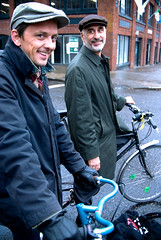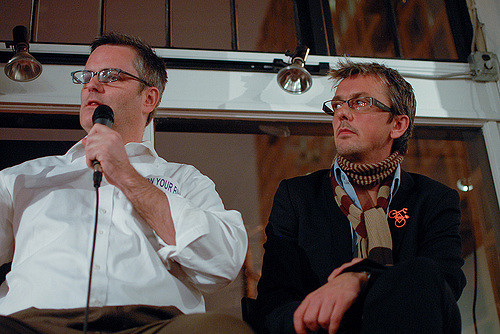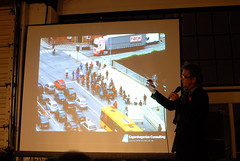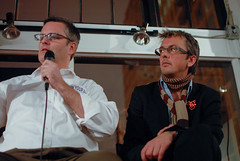
PBOT’s Roger Geller took a spin
before last night’s event.
(Photos © J. Maus)
If Portland wants to push cycling into the mainstream, and reach usage levels similar to European cities, we need to make it easy, focus on the positives, tame automobiles, and do our research to counter anti-bike sentiment. That was some of the advice given by Copenhagenize’s Mikael Colville-Andersen at a sold-out event last night.
Colville-Andersen — who’s on a tour through the U.S. sponsored by the Danish Embassy — joined Mayor Sam Adams for a special reception for the Dreams on Wheels exhibit which is currently on display at the Oregon Manifest Bike Union in Northwest Portland. He started the night out with a presentation titled, Marketing Bicycle Culture: Five Goal to Promote Urban Bicycling.
Colville-Andersen opened his presentation by emphasizing that in his hometown, bicycles are just normal, everyday things:
“Our relationship to the bicycle in Copenhagen is much like the vacuum cleaner. We don’t have five of them that we keep polished and well-oiled, there are no vacuum cleaner enthusiasts, we don’t go to a specialty shop to buy one or wear special clothes while we vacuum. The bicycle and the vacuum cleaner are just tools. One of them we clean our homes with, the other we use to transport ourselves around the city.”
Last night, the crowd heard loud and clear that in Copenhagen, there are no “cyclists”, just people who ride bicycles everyday. Colville-Andersen calls them “citizen cyclists”.
When asked why they ride, Copenhagen residents overwhelmingly (56% in a recent survey) say because it’s easy and fast. To Colville-Andersen, that backs up his first goal, a concept he calls, “A2Bism”, which is simply a concept that if there is infrastructure in place that makes the bicycle the easiest and fastest tool to get from a to b, then a high rate of bicycle usage will follow.
“This is all people want. We’re all homo-sapiens. It doesn’t matter if we’re on foot, on a bicycle or in a car, we just want to get there quick. We’re rivers. We will find the quickest route.”
To illustrate this point, he shared an anecdote. In the 1980s, when Copenhagen was experiencing a boom in bicycling, city officials worried that too many people were riding on the busy main streets. “They thought, we’ve got to stop that, it’s not safe.” Their solution was to direct bike traffic to the backstreet by building high-quality cycle tracks through neighborhoods.
The problem was that the neighborhood routes meant people had to ride 10-15 minutes out of their way to get from a to b. The result? No one used them. “It was a flop. So, the city shrugged and went, ‘fine, we’ll put them on the main streets'”.
The lesson, says Colville-Andersen, is that planners should put bicycle infrastructure where people actually want to go, not where engineers think they should go.
Besides his popular blogs and films, Colville-Andersen owns a marketing firm that specializes in helping cities “Copenhagenize” themselves. He believes that more planners and advocates need to apply basic marketing principles to bicycling in order for it to appeal to the masses.
Colville-Andersen feels that “Bicycles are a multi-vitamin Viagra pill for the urban landscape.” Unfortunately, he says, bicycles are too often marketed in a way that makes them seem “dangerous and sweaty”. “These are not unique selling points that are going to get a lot of people to buy this product.”
He pointed out beautiful vintage bicycle posters and reminded the crowd of how the industry used to sell the product. “It was one of the most brilliant periods in the history of marketing and people all over the world bought this product [bicycles] and used it.”
In an anecdote to illustrate the positive impact bicycles have had on the world, Colville-Andersen shared a light-hearted story about how sociologists have found that bicycles have even improved the gene pool:
“The bicycle provided an explosion of mobility… Back in the day if you were a farmhand or a laborer, rural areas were spread out, you couldn’t get to the next town, it was too far. Bicycles showed up and all the sudden you could look for dates in a larger radius. Your wife radius increased dramatically, so it actually improved the gene pool.”
Colville-Andersen’s second goal is to “always sell bicycles positively”. He compared the marketing of bicycles to that of cars:
“You never hear them [car industry] talking negatively about their product at all. Never. They’ll never tell you that driving is considered to be the most difficult task homo sapiens have had to master. This is actually true, hunting mammoths is nothing compared to driving a car. They’ll never tell you that the level of dangerous hydorcarbon particles in the air are actually higher inside the car than if you ride a bike next to them… They never tell you your risk of head injury is higher in a car than on a bicycle and at no point have we ever seen the car industry promote motorist helmets.”
A key to making cycling mainstream, according to Colville-Andersen, is to address the dangers of the automobile. He equated the car with a bull running around a china shop.
“Someone has let a sacred bull in society’s China shop… We can all agree that there is a bull in the china shop, we can all be realistic and think the bull’s not going anywhere (it’s gotten too big to fit out the door now). So we bubble wrap all the pieces of expensive china and meanwhile the bull just knocked over eight shelves in aisle 9 and took a shit on the floor. It’s strange, we’ve developed this fantastic capacity to completely and utterly ignore the bull.”
Continuing with the bull/car comparison, he said that knowing that there’s a bull in the china shop, people should do something to “limit its destructive capabilities” such as “castrate it to make it calmer, tie it down, or build a fence around it.”
Colville-Andersen’s third goal is to simply address “the bull”, meaning, if cities really want to attain high levels of bicycle use, they must begin to acknowledge that the cars are causing havoc and their power and dominance on the urban landscape must be reigned in.
On a similar note, Colville-Andersen said he dreams about a day when cars have warning labels similar to those mandated on cigarette packages:
“Imagine if we woke up and all the cars had warning labels on 30% of their surface area [that’s the law for cigs]. Imagine what would happen to the mindsets of our population. After two months you’d have people opening their garage, looking at the car, looking at the bike and saying, ‘I’m not going to risk my life, I’m taking the bike'”.
The role of the bicycling “subculture” was also addressed by Colville-Andersen. He feels that in order to “mainstream bicycling” it needs to be re-branded as a “normal, borderline boring transport option.” To do this he feels like cities should “focus less on subcultures”.
Colville-Andersen said Portland is already doing a lot of what he preaches. He gushed about our city via Twitter this morning and said that during our ride last night he “couldn’t stop grinning.” But even though he’s impressed by what we’re doing, he still says we have work to do.
In a Q&A that followed, Mapes asked Mayor Adams if it’s realistic for Portland to reach Copenhagen levels of bicycling. Adams said yes. He pointed to PBOT’s efforts to remove the “real and perceived fear of cars” by creating more separated facilities like the buffered lanes recently installed on Stark and Oak and the cycle track on Broadway.
Adams described the importance of making fully developed bike boulevards. “When they [people riding bicycles] can get on their bike and never have to put their foot down and not have to blow through stop signs…if we can do that we can get to Copenhagen’s level of bicycling by 2030.”
Colville-Andersen said last night that what took Copenhagen 30 years to achieve could be done today in 5-10 years. This is in part because all the (planning and engineering) mistakes have been made and the case for bicycling is stronger now than it has ever been. He also pointed out that to do that it will take “visionary political decision-making.”
Portland is definitely on the right path. Our Bicycle Plan for 2030 is a map to help us reach our goals and there were a lot of PBOT staffers (and other policymakers) at that event last night who are surely still mulling over some of Colville-Andersen’s insights.
— See more photos of the event and a pre-event bike ride with Colville-Andersen in the gallery.




